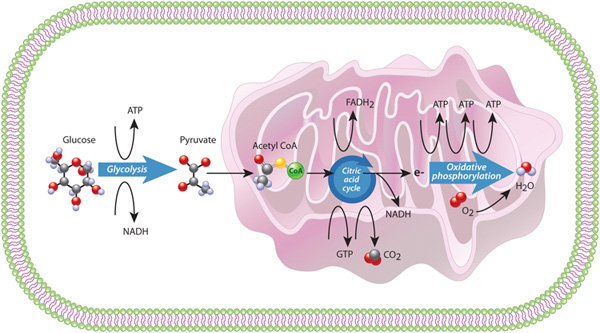Energy is required for carbon dioxide molecules to form six-carbon sugar molecules. This energy is obtained from a source such as food molecules or light from the sun and through processes like glycolysis the citric acid cycle and oxidative phosphorylation an energy-rich molecule is then created.

Cell Energy Cell Functions Learn Science At Scitable
Active transport in the form of.

. What distinguishing feature is described in the given. Oxygen molecules release energy in the form of heat during combustion reactions. Energy comes from the three main nutrients carbohydrates protein and fats with carbohydrates being the most important energy source.
Adenosine triphosphate or ATP is the primary energy currency in cells. Scientists use the term bioenergetics to describe the concept of energy flow through living systems such as cells. Identify ways in which a scientific claim is.
Water molecules and radiant energy are necessary for anaerobic respiration to take place. A bacterial cell culture is subjected to high pressure. It uses glucose and oxygen and makes ATP and a waste product carbon dioxide the same carbon dioxide we exhale.
Energy development is the field of activities focused on obtaining sources of energy from natural resources. ATP releases energy when the phosphodiester bonds are broken and ATP is converted to ADP and a phosphate group. The energy-releasing chemical breakdown of food molecules such as glucose and the storage of potential energy in a form that cells can use to perform work.
Membrane proteins use the energy of the cells resting potential to move particles against the concentration gradient. Cellular respiration is a set of metabolic reactions and processes that take place in the cells of organisms to convert biochemical energy from nutrients into adenosine triphosphate ATP and then release waste products. Energy decreases as it is lost as heat to the environment.
Anabolic pathways are those that require energy to synthesize larger molecules. It releases energy when it gains a phosphate group. - endomembrane system 6.
Describe andor explain the cell theory. How does it maintain the integrity of cell structure. Describe how continuous investigations and new scientific information influenced the development of the cell theory.
Cellular processes such as the building and breaking down of complex molecules occur through stepwise chemical reactions. Energy gathering best describes the nature of cellular respiration. It is the absorption of CO2 from the air and it occurs during the light-dependent reactions.
The student is looking for evidence that spindle fibers are separating the chromosomes to ensure that each new nucleus has one copy of each chromosome. C6H12O66 O2--6 H2O6 CO2ATP. Glucose fructose starch The cells of all organisms and therefore all organisms require a continuous supply of energy for the performance of their daily vital activities Represented by the chemical equation.
Some of these chemical reactions are spontaneous and release energy whereas others require energy to proceed. - It has a rigid cell wall made up of peptidoglycan. ATP stores energy in phosphate ester bonds.
It is the production of CO2 during regeneration and it. A student is trying to find a cell in a particular phase of mitosis. Catabolic pathways are those that generate energy by breaking down larger molecules.
It provides energy by transferring the phosphate molecule from its structure by the process of phosphorylation. In cases where carbohydrates have been depleted the body can utilise protein and fats for energy. The diagram shows cells in different phases of mitosis.
It is this energy that is used to fuel cellular functions. Energy conservation and efficiency measures reduce the demand for energy development and. Which statement best explains the flow of energy as it moves through the different levels.
Cell A contains a part that is responsible for spring materials to be transported. Catabolism breaking down molecules Anabolic and catabolic pathways. Cells use energy in order to grow regulate metabolism and reproduce.
It is the reduction of CO2 and it occurs during the Calvin cycle. Respiration transforms chemical food energy into usable energy by the cell by converting glucose and oxygen into ATP. Both types of pathways are required for maintaining the cells energy balance.
The release of energy from energy-storing compounds ie. The transfer of electrons between molecules via oxidation and reduction is important because most of the energy stored in atoms is in the form of high-energy electrons. It stores energy as glucose.
Your cells use a process called cellular respiration which make the energy we need. It is the conversion of CO2 into organic compounds and it forms 3-PGA. The aerobic harvesting of energy from food molecules.
The transfer of energy in the form of electrons allows the cell to transfer and use energy in an incremental fashion. Adenosine triphosphate ATP is the major energy source that is essential for cellular activity and functions. It transfers energy to cell processes.
These activities include production of renewable nuclear and fossil fuel derived sources of energy and for the recovery and reuse of energy that would otherwise be wasted. Membrane proteins provide a pathway for larger particles to move across the cell membrane and bring the cell and environment closer to equilibrium. Your metabolism is the chemical reactions in the bodys cells that change this food into energy.
The correct answer between all the choices given is the second choice or. Which best describes the role of nitrogen-fixing bacteria. An energy pyramid is pictured.
Up to 24 cash back SC912L141 Describe the scientific theory of cells cell theory and relate the history of its discovery to the process of science. Report an issue. In small packages rather than as a single.

Cell Energy Cell Functions Learn Science At Scitable

Using New Single Cell Technologies Researchers Create Comprehensive Map Of Human B Cell Development Technology Org B Cell Development Systems Biology

Infographic The Hierarchy Of Life Biology Lessons Human Body Systems Nursing School Survival

Plant Vs Animal Cells Venn Diagram For Educational Purposes Venn Diagram Plant And Animal Cells Animal Cell Biology Lessons
0 Comments